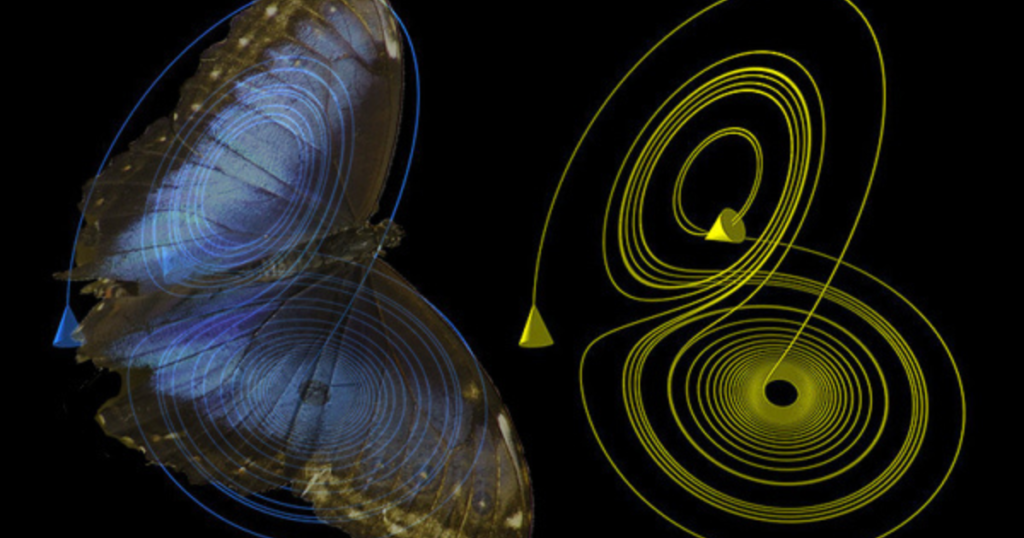
Edward Lorenz, a meteorologist, invented the term “butterfly effect” in the 1960s to describe his observation that even slight changes in a weather system’s beginning conditions can have enormous consequences. One well-known illustration of chaos theory is the “butterfly effect,” the belief that the movement of a single butterfly in Brazil might trigger a tornado in Texas.
The butterfly effect has been used in many different disciplines, from economics to psychology, in recent years, expanding its original scope beyond meteorology. The butterfly effect often illustrates how seemingly minor events may have far-reaching consequences in more intricate systems. This article will discuss the evidence for and against the butterfly effect as a scientific reality.
While it’s true that even seemingly insignificant actions can have far-reaching consequences, it’s pretty unlikely that a single butterfly could cause a noticeable shift in the weather. It’s not the best illustration, but it gets the point across and helps spark creativity.
When the Butterfly Effect Took Flight
50 years ago, on a cold winter day, Edward Lorenz, a mild-mannered professor of meteorology at MIT, entered some numbers into a computer program simulating weather patterns and then went to get a cup of coffee. Upon his return, he discovered a game-changing finding in the scientific community.
Twelve variables were used as the foundation for the computer model, each representing a different factor (such as temperature or wind speed). Those values could be plotted as an increasing or decreasing line over time.
Earlier in the day, Lorenz had run a simulation and was doing it again, but this time he rounded off one variable from .506127 to.506. That seemingly insignificant change dramatically impacted his program’s entire pattern, altering the simulated weather for two months.
The unexpected outcome prompted a profound realization for Lorenz about the workings of nature: minor adjustments can have significant results. Lorenz’s hypothesis that a butterfly’s wingbeat could trigger a tornado inspired the term “butterfly effect” to describe this chain of events. Further, a major implication of the butterfly effect, also known as “sensitive dependence on initial conditions,” is that accurate prediction of the future is often nearly impossible.
Lorenz’s impact was subtle at first but would have far-reaching repercussions, like flapping a wing. Lorenz summarized his study in a 1963 publication titled “Deterministic Nonperiodic Flow,” which was mentioned precisely three times in the next decade by scholars working in fields other than meteorology.
His discovery became the cornerstone of chaos theory, quickly gaining traction in the 1970s and 1980s across disciplines such as meteorology, geology, and biology. A professor of geophysics at MIT, Daniel Rothman, describes it as “a wonderful example of an apparently esoteric piece of mathematics that had experimentally verifiable applications in the real world.”
Lorenz’s work, as many scientists would realize by the 1980s, also posed a threat to the classical interpretation of the natural world. Similarly, French mathematician Pierre-Simon Laplace argued in his 1814 book A Philosophical Essay on Probabilities that if we knew everything about the current condition of the universe, “nothing would be uncertain and the future, as the past, would be present to [our] eyes.”

In the deterministic universe described by Newton and Laplace, randomness has no place; as Lorenz once put it, “only one thing can happen next.” Every subsequent event is totally dependent on the current state of affairs. Lorenz’s own deterministic equations showed how readily the ideal of complete knowledge collapses under scrutiny.
Given the significance of this seemingly insignificant alteration to his simulation, it follows that the inherent uncertainty in every human measurement has the potential to be amplified into spectacularly inaccurate predictions.
Can a Butterfly in Brazil Really Cause a Tornado in Texas?
The idea that a butterfly’s wing in Brazil might trigger a chain reaction of meteorological phenomena that, weeks later, encourages the genesis of a tornado in Texas is poetic. This so-called “butterfly effect” is often cited as the reason why weather forecasts are only accurate up to a few days in advance for chaotic systems like the atmosphere.

Knowing exactly when and where a storm would make landfall several days out would require knowing the precise details of every variable affecting the environment, which is impossible. The fact that the computer model that led to the discovery of the butterfly effect looks like a butterfly only adds to its appeal.
The model, developed in the 1960s by the mathematician Edward Lorenz, is a line that alternately spirals around two neighboring ovals. It represents the chaotic solution to a system of connected equations. Lorenz observed that the attractor’s shape was highly conditional. Simply shifting the origin by the width of a single scale on the wing resulted in an entirely new butterfly being drawn by the line.
Since the discovery of the strange attractor, the butterfly effect has been used to explain the emergence of chaos in various contexts, including the stock market and the Texas tornado season, among others. However, this is despite the fact that it is untrue: a butterfly in Brazil can flap its wings as much as it wants, but it still can’t create a tornado in Texas.
According to mathematician and author David Orrell’s interview with Life’s Little Mysteries, “If a butterfly flaps its wings, the effect really just gets damped out.”
Quantum Scientists Discover Inaccuracies in the Butterfly Effect
Scientists have debunked the butterfly effect at the quantum level, showing that past actions have no direct consequences in the present. The simulation pretends to send a piece of data back in time. The data gets subsequently corrupted.
However, when information is brought back to the “present,” it is largely unaltered, and counterintuitively, the final piece of information returns with less damage the further back it is taken.
Due to the impossibility of time travel, this effect is unique to quantum mechanics and the simulations made possible by quantum computers. “On a quantum computer, there is no problem simulating opposite-in-time evolution,” said Nikolai Sinitsyn, a Los Alamos National Laboratory theoretical physicist.

If we go back in time, make a minor alteration, and then come back, we can see what happens to a complicated quantum universe. The results showed that the world continues to exist, ruling out the possibility of a butterfly effect in quantum physics. To investigate the butterfly effect, the researchers employed an IBM-Q quantum processor equipped with quantum gates, which can simulate both forward and reverse causality.
The ‘bits’ used in the chips of typical computers and processors were binary digits, and they can only be in one of two states: “on” or “off.” Qubits, the quantum equivalent of a digital bit, can be on and off simultaneously or somewhere in between, making them ideal for quantum computers.
In the simulation, a person “time travels” by sending a qubit into the past. Measuring the qubit by a time traveler from the past disrupts it and modifies its quantum correlations. This is because a quantum-behaving atom can be jarred out of its quantum state by coming into even the slightest touch with another atom.
The simulation is then continued to bring the qubit up to date. It was discovered that the data was resistant to slight changes, contrary to the popular belief that data is irretrievable if even a single change is made (the “stepping on a butterfly” metaphor). Sinitsyn explained that the concept of chaos in classical physics and quantum mechanics requires distinct interpretations.
This finding has applications in both the testing of quantum devices and the concealment of information by transforming it into a quantum entangled state. Since in quantum mechanics, there is no such thing as a “butterfly effect,” if the simulation is running and the result is different, it would indicate that the quantum processor is not functioning correctly.
Case Study
Covid-19
Disease in a globally interconnected society, COVID-19, is a perfect example of how even a seemingly insignificant event can have far-reaching consequences. Given the interwoven nature of our globalized world, where it is impossible to prevent something happening in one country from spreading to another ones, some have speculated that a pandemic was inevitable.
As an example of the butterfly effect, investor Navindu Katugampola cites the development of COVID-19. It all started in a Chinese food market and has since spread to practically every major city around the globe. Because of our interconnectedness, a seemingly insignificant event has far-reaching implications.
Moreover, COVID-19 demonstrates how various sectors are interconnected as part of a larger system and how alterations in one area, such as health, can have knock-on effects on others, such as the economy, the mental health system, and the natural environment.
Individual Actions and Global Warming
The butterfly effect, as previously hypothesized, provides evidence that even seemingly insignificant actions can have a cumulative influence on the planet. There is no consensus on what will happen to Earth due to human activity. However, it is widely acknowledged that human activity has already significantly affected the environment and altered natural environments.
Although the Earth’s ecosystems are interconnected and complex, the butterfly effect reminds us that the actions of a single generation can have far-reaching and terrifying impacts on the entire system. The butterfly effect does not pretend to be able to trace how minor actions have greater repercussions, but it does show that what we do matters even if we may not be able to forecast exactly what would happen if we continue as we are.
The butterfly effect counters the conventional wisdom that we are doomed and that no one’s efforts can alter the course of climate change by suggesting that even seemingly insignificant actions can have far-reaching consequences.
Controversies
The widespread acceptance of the butterfly effect is not always accepted without question. The butterfly effect is often compared to the concept of leverage in common discourse. According to the book Team of Teams: New Rules of Engagement for a Complex World, this comparison is incorrect because it misrepresents the butterfly effect, which is the idea that a little change can have large-scale consequences.
This is because outcomes cannot be determined from starting conditions. Although seemingly insignificant events can have far-reaching consequences, predicting the precise link between such actions and their outcomes is extremely challenging, if not impossible.
While it’s true that seemingly insignificant actions can have far-reaching effects, it’s also true that they might not. Due to the unpredictability of chaos, the butterfly effect should not be interpreted as evidence that minor adjustments can significantly alter the course of events.
Furthermore, many economic models fail to account for the butterfly effect. Many standard economic models assume that consumers consistently exhibit predictable behavior patterns due to their clearly defined preferences. However, if the butterfly effect is real, it suggests that these models are wrong and perhaps no universal predictions of human behavior are possible.
While it would be extreme to throw out the concept of predictions altogether, the butterfly effect shows that causal relationships are not always straightforward and economic models may need to be adjusted to account for some uncertainty.




